Aesculus hippocastanum L.
Horse Chestnut

Introduced
CC = n/a
CW =
MOC = 0
© SRTurner
Aesculus hippocastanum L.Horse Chestnut | |
 |
Introduced CC = n/a CW = MOC = 0 |
© SRTurner |
|
Family - Sapindaceae Habit - Tree. Stem - To 25 m.
Leaves - Opposite, palmately compound. Leaflets 7-9, cuneate-obovate, 10-25 cm long, acute, irregularly toothed, abaxially pubescent when young but becoming glabrous with age.
Inflorescences - Conical racemes 20-30 cm long.
Flowers - Calyces 5-7 mm, cup-shaped, fused in basal half. Petals 4 or 5. Upper and lateral petals with red or yellow markings, cordate at base, clawed. Fifth petal obovate, broadly clawed. Stamens 6-8. Ovary usually 3 locular.
Fruits - Spiny, to 5 cm. Flowering - April - May. Habitat - Cultivated. Origin - Native to Eurasia. Lookalikes - None close when flowering. Other info. - This striking and majestic tree does not occur naturally in Missouri, existing in the state only from deliberate plantings and not thus far escaping cultivation. Its distribution in North America is similarly widely scattered and sporadic. The inflorescences are extraordinary for their size and showiness. As with other members of the genus, the seeds contain toxins and should not be eaten. Following treatment to remove toxins, extracts of the leaves and seeds have been used to treat a variety of ailments. Yatskievych reports that the seeds are eaten after being roasted. Photographs taken at Faust County Park, St. Louis County, MO, 5-7-2014 and 5-6-2019 (SRTurner). |